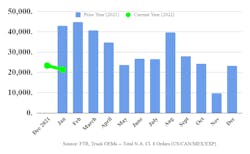Preliminary net orders in January for new Class 8 commercial vehicles were 21,300 units, while net Classes 5-7 orders dropped to 16,500 units, according to ACT Research.
Another research group, FTR Transportation Intelligence, reported similar preliminary North American Class 8 net orders of 21,400 units in January. FTR's January order total was down 8% month-over-month—and down 50% year-over-year. Class 8 orders have totaled 343,000 units over the last 12 months, FTR reported.
See also: Trucking analysts project 'steady' improvements for 2022
“Constrained production capabilities and long backlogs continue to hamper new order activity,” said Kenny Vieth, ACT’s president and senior analyst. “Order weakness continues to be primarily, if not entirely, due to supply side shortages that continue to restrict production.”
Don Ake, vice president of commercial vehicles for FTR, added: “January orders met expectations. As a group, the OEMs are entering orders at the same rate as production. Backlogs have tracked in a narrow range for the last 10 months, which is odd in this cyclical industry. Normally, this would indicate a very stable market. In this case, it reflects a market frozen by a weak supply chain.”
Ake said in a release from FTR that January orders continued to track in a restricted range with the total for the month equaling the average of the last four months. OEMs continue to match order rates to build rates as they manage backlogs monthly. OEMs are not entering all their 2022 commitments because they do not want to overbook due to the uncertain supply chain.
“There is still tremendous demand for new trucks,” Ake added. “The order totals for the last 12 months, at 343,000 units, would equate to a robust production year. The orders are there but the OEMs continue to be limited in what they can produce due to shortages of semiconductors and other components.
“The big negative to the January order volume is that it indicates the supply chain has not improved yet from the end of last year. OEMs are not confident they can get parts, so they limit the number of orders they enter. Order totals will rise as soon as supply chain conditions improve.”
ACT’s Vieth added: “For Class 8, with backlogs stretching through 2022 and still no clear visibility on the easing of the everything shortage, January’s net order haul reflects the ongoing conservative approach by OEMs looking to limit the risk of overbooking and underbuilding that plagued the industry in 2021.”
ACT’s State of the Industry: Classes 5-8 Vehicles report provides a monthly look at the current production, sales, and general state of the on-road heavy- and medium-duty commercial vehicle markets in North America.
The ACT report differentiates market indicators by Class 5, Classes 6-7 chassis, and Class 8 trucks and tractors, detailing measures such as backlog, build, inventory, new orders, cancellations, net orders, and retail sales. Additionally, Class 5 and Classes 6-7 are segmented by trucks, buses, RVs, and step vans.
The Class 8 market is segmented into trucks and tractors, with and without sleeper cabs. The report includes a six-month industry build plan, a backlog timing analysis, and historical data from 1996 to the present. A first look at preliminary net orders is also published in conjunction with this report.




